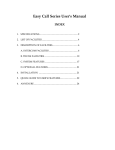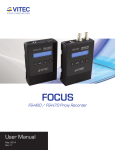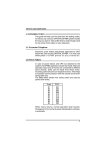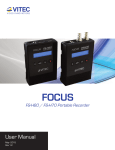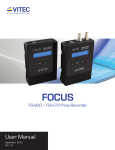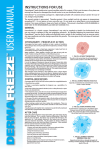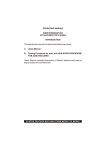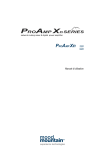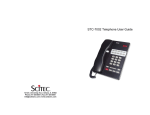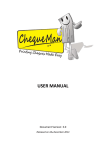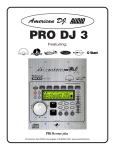Download Quantum Series User`s Manual
Transcript
Thanks for selecting PREMIER QUANTUM Series for your requirement of Voice Communication Quantum series comes in four models. 1. 416 expandable up to 816 2. 416 expandable up to 424 3. 424 expandable up to 848 4. 448 expandable up to 896 All these models use the same CPU card, 8 Line extension cards and 4 Line Trunk cards. The units come with built in ASMDR, CLI, and SMPS with 12 V Battery charger and MDF. The front panel has a transparent section through which the operator can see the LED field to know if an extension or a trunk is busy or free. The enclosure is made up of high grade MS sheet with powder coating and the sleek design will add to any front office interior decor. The optional Operator console will add to the efficiency of the operator in handling any high traffic with ease. The operation procedure has been made very logical and simple for ease of operation. INDEX 1. SPECIFICATIONS 5 2. LIST OF FACILITIES 7 3. DESCRIPTION OF FACILITIES: A. EXTENSION FACILITIES 10 B. TRUNK FACILITIES 18 C. SYSTEM FACILITIES 33 D. OPTIONAL FACILITIES 43 4. ANNEXURE 46 5. INSTALLATION 47 SPECIFICATIONS No. of trunks : 1 to 8 (protected) No. of Extensions : 8 to 48 depending on the model No. of Links : 8 for intercom and a link each for every Trunk Line termination : Extensions and Trunks are terminated on an MDF PCB Mounted on the side of the unit and covered by the front Panel Power Fail Extensions : The first eight Extensions, 1st Trunk to 1st Extension, 2nd Trunk to 2nd Extension etc. Switching Scheme : Space Division solid state cross point switch. Totally Non Blocking for Trunk calls and call transfer. Tones Provided Code Expansion Frequency DT Dial Tone 400 Hz modulated Continuous RBT Ring Back 400 Hz modulated 1 sec On/2 sec Off RT1 Ring Tone 50Hz / 60v AC 0.4sec ON, 0.2sec OFF 0.4sec ON, 2.2sec OFF For Trunk Calls. RT2 Ring Tone 2 1 sec ON / 2 sec OFF For Intercom Calls. RT3 Ring Tone 3 1 sec ON / 1 sec OFF For Fast Ring. NUT Number unobtainable Tone 400 Hz 0.4sec ON/0.4 sec OFF BT Busy Tone 400 Hz 1sec ON / 0.4 sec OFF SOT Service over Tone 400 Hz CAT Call Alert Tone 400 Hz WT Warning Tone Frame (seconds) 400 Hz Telephone Instruments : Any DOT approved tone / pulse push button Telephone with the following specifications a) Dial Speed : 10 +/- 0.5 impulses/sec b) Make break ratio : 33 % and 67 % c) Tone Pairs : Low Group 697, 770, 852, 941 Hz Upper group 1209, 1336, 1477 Hz Power Supply : 230 V AC + / - 10% 45 to 60 Hz Battery (Optional) : Maintenance free 12 V 7AH max Power consumption : 25 to 50 Watts depending on the model and traffic Size : 848 Height - 150 cm Width - 340 cm Length - 430 cm Weight - 11 Kgs 816 / 424 Height - 150 cm Width - 340 cm Length - 325 cm Weight - 8 Kgs Mounting arrangement : The unit has to be wall mounted at least 2 feet above the ground level. Environment : Temp 0 to 45 degree centigrade for operation. Humidity 90% max noncondensing. LIST OF FACILITIES A. INTERCOM FACILITIES 1. Intercom call 2. Intercom call consult 3. Intercom call flip flop 4. Intercom call conference 5. Hot line 6. Alarm 7. Call forward all calls 8. Call forward if busy 9. Call forward no answer 10. Ring when free (call queuing) 11. Ring when active 12. Call pickup 13. Intercom CLI 14. Barge – in 15. Do not disturb 16. Dynamic local lock 17. Dynamic STD lock 18. Self Ring Test 19. Follow Me 20. Announcement 21. Personal Memory Dialing for each extn B. TRUNK FACILITIES 1. “0” Trunk dialing 2. Particular Trunk dialing 3. Call Queuing / Camp on trunk a) General queue b) Particular Queue 4. Last number Redial 5. Hot Trunk Line 6. Trunk locking 7. Call only incoming 8. Pulse or DTMF dialing 9. Auto Fax Homing 10. Automatic power fail cut through 11. Extn class of service 12. Denied Table 13. Trunk call pick up 14. Call warning 15. Call parking 16. 17. 18. 19. 20. 21. 22. 23. 24. 25. 26. 27. 28. 29. 30. 31. 32. Trunk call consult with extension Trunk call consult with another trunk Call consult trunk flip flop Trunk call transfer Call Transfer Blind Call transfer persistent a. Busy with extension b. Busy with trunk Barge-in on Trunk Call transfer with barge in a. Busy with extension b. Busy with trunk Trunk call conference a) One Trunk and Two Extensions b) Two Trunk and One Extension Trunk outgoing call time limiting to 3mins, 5mins or no limit Incoming call time limiting to 5mins or no limit Trunk grouping CLI on Trunk Battery reversal Centrex Lines 70 Grouping DID/Fax trunk with or without message C. SYSTEM FACILITIES 1. Night mode / Night mode 2. Ringing Options 3. Round robin extn selection for individual trunks 4. Simultaneous ringing extn selection for individual trunk 5. Staircase extn selection for individual trunks 6. Call forward protection 7. Fax extn selection 8. Fax trunk selection 9. Distinctive ringing 10. Direct Inward Dialing (DID) 11. To set Time, Date and Day 12. Auto day and night mode programming 13. Flexible numbering scheme 14. ASMDR 15. 16. 17. 18. 19. 20. 21. 22. 23. Recording of Incoming calls Programmable Operator Position Printing Paging Global Memory Dialing Remote Programming Factory Set Programming Programmable Flash timing for each extn Hotel features with Check in and Check out D. OPTIONAL FEATURES Voice Guided DISA DESCRIPTION OF FACILITIES A. INTERCOM FACILITIES 1. Intercom Call: Lift the handset, dial the required extn number. If called extn is free, you will receive RBT, otherwise you will receive ‘Busy Tone’. 2. Intercom call consult: When you are in intercom mode with an extn you can consult any other extn by flashing and then dialing the required extn number. The first extn will be in hold. If the called extn is busy you will get busy tone and then you can get back by flashing. If the called extn is free you will be connected to him when answered. After consultations are over you can get connected to your waiting extn by dialing flash and dial 1 or if the second extn disconnects the call. 3. Intercom call Flip Flop: 4. After establishing call consult you can flip flop between the two extensions by dialing flash and 1. To go back to the first party dial flash and 1. The second party will go on hold and you can talk to the first party. You can alternate between the two extensions. If you want to drop the current extension and get back to waiting extension hook flash and dial 8. The second extension can’t drop himself. Intercom Call conference: After establishing call consult you can bring both the extns in conference with you by dialing flash and 9. If the calling extn puts down he will be disconnected where as the other two can continue the conversation. 5. Hotline: Whenever you lift your handset, if you want to directly ring at a specified extension (Boss-Secretary feature) you can set up Hotline. For this lift and enter into feature mode and dial 48 & 0 & extn no. for delayed Hotline or Dial 48 & 1 & extn no. for immediate Hotline. Here after whenever you lift your handset, the specified telephone if free will start ringing. 6. Alarm: The Quantum series comes equipped with Real Time Clock. You can set alarm or appointment reminders. To set up alarm enter into feature mode and Dial 50 and Hours and Minutes in 24 hours format. For example if you want to set up alarm for 3’O clock in the afternoon then Enter into feature mode and dial 50 15 00. Now at 3 in the afternoon if your telephone is free it will start ringing in the fast mode. If you lift the phone you will here music to indicate you that it was the alarm request that was ringing the phone. You can have only one alarm setting per extension. To cancel any alarm you have already set, lift handset and Enter into feature mode and dial 51. 7. Call forward all calls: If you want to forward all your incoming calls to another extn then lift the handset and enter into feature mode and dial 41 and the required extn number 8. Call forward if busy: If you want to call forward your calls, only if your line is busy, then lift the handset and enter into feature mode and dial 42 and the required extn number. Now onwards, if you are found busy, your incoming calls will ring at this call forwarded extn. 9. Call forward no answer: If you want to call forward your calls, only if you are not attending to them then lift the handset and enter into feature mode and dial 43 and the required extn number. Now onwards, if you don’t answer the calls within five rings, your incoming calls will ring at call forwarded extn. To cancel any call forward you have put, lift the handset and enter into feature mode and dial 44. Call forward can also be protected by an extn. Calls cannot be forwarded to the extn enabled with call forward protect feature. Note: To enter into feature mode, lift and dial # and your 3 digit personal password (ppw), default PPW is ‘000’. 10. Ring when free (call queuing): If you find an extn busy then dial flash and 8 over the engaged tone. Once the called extn becomes free and your extn also is free then both extns start ringing. Call is established once both answer the call. 11. Ring when active: In an intercom call if you find that the called party is not available and hence not answering and if you want to call him as soon as he comes back and starts making calls, then dial flash and 8 over RBT. The RBT stops indicating that the request is accepted. Once the called extn becomes active and both the extns are free, they will ring in the fast ringing mode and call is established once they are answered. 12. Call pickup: If an extn is ringing and no one answers it, you can pickup the call on your extn by dialing 8 and the ringing extn number and the call will be connected to you and the ring will stop on the ringing extn. If you do not know the ringing extn number, then just dial 8 and wait for 2sec the call will be connected to you.(Pl note if you dial only 8 then any ringing phone’s call may be connected to you) This facility is possible if you are free or you are on trunk. If you are on trunk, flash to put your trunk on hold and do call pickup. When the calling extn puts down and you also put down you will be rung for your waiting trunk. This facility is not possible if you are talking to an extn in the intercom mode. If you want to do call pick up, disconnect the present local conversation and dial 8 and extn no or only 88. 13. Intercom CLI: If an extn has CLI enabled phone then on an intercom call, the calling extn number will be displayed on the telephone instrument. This extn should be programmed as a CLI phone. Also if an incoming call is transferred to this extn and if CLI had been received then the external CLI will be displayed on the extn. 14. Barge-in on extn: While dialing for an extn, if you find the extn is busy in intercom mode or busy with trunk you can barge-in on that extn by dialing flash and 9 over busy tone (to barge in with warning tone) or flash and 7 over busy tone (for barge in without warning tone). If you put down, you will be disconnected without affecting the other extns. Whereas if the calling extn on whom you have barged-in puts down all the three will be disconnected. You can even transfer trunk calls by establishing barge in. For this press flash and dial extn no. and on busy tone dial 9. You will be put in conversation with the busy extn and you can inform about the pending trunk call and then disconnect. The calling extn will start getting the warning tone to indicate the waiting trunk call. On his disconnecting the present intercom call his extn will ring for the transferred call. Barge-in with or without tone: Extensions can be programmed such that they can barge in on others with or without warning tone. Barge-in can also be protected to an extn. Bargein can not be effected on the extn enabled with the barge in protect feature. 15. Do not disturb: To activate DND, lift the handset and enter into feature mode and dial 45, SOT* indicates that DND is activated. During DND on, extn will not ring for any incoming call. However outgoing call can be made as usual. To cancel DND, lift the handset and enter into feature mode and dial 46. * Service Over Tone 16. Dynamic Local Lock: To prevent misuse of your extn by others when you are away just enable this facility on your extn. On enabling this on your extn outgoing calls cannot be made until you disable the lock. To enable Dynamic Lock enter into feature mode and dial 62. Now onwards outgoing calls are not allowed from this extension. To disable the lock enter into feature mode and dial 61. 17. Dynamic STD Lock: On enabling this feature, STD calls from your extn will not be allowed. This facility is useful only if your extn is allowed to make STD calls. This facility can be invoked from any extn. To enable dynamic STD lock, enter into feature mode and dial 64. Now onwards STD calls are barred from this extn. To disable the lock enter into feature mode and dial 63. 18. Self Ring Test: To check your own extn no. or to check whether your telephone rings, you lift and dial your own extn no. Music will be returned and upon putting down the extn will start ringing. 19. Follow Me: If you are away from your desk but available at some other extn then you can program such that all calls received at your extn can automatically be diverted to the extn where you are available. Now, from this telephone you enter into feature mode and dial your Extn no. If the Extn from which you are registering the Follow Me has not already activated any CF or FM then your request will be acknowledged with confirmation tone. 20. Announcement: Any extn that has been authorized to come on the public address system can enter into feature mode and dial 54. After initial burst of music on the PA system this extension will be connected to it. Only pre amp speech output is provided. The amplifier and speaker should be provided by the user. 21. Personal Memory Dialing: Each extn can have its own 10 memory dialing numbers stored. They dial the numbers by dialing the code 990 to 999. To program personnel memory enter into feature mode and dial 57 and after the conformation tone dial the location (0-9) where the No. is to be stored and after conformation tone, dial ‘70’ for any trunk or 71, 72, 73, 74, 75, 76, 77 or 78 for particular trunk & dial the telephone number to be stored and ‘*’ to complete one memory entry. To store more memory dialing locations dial location no. (0-9) & repeat the above procedure. (For eg. To store 08023419952 at location 952, dial # PPW 57 + 2 + 70 + 08023419952 + *). B. TRUNK FACILITIES 1. ‘0’ Trunk Dialing Dial ‘0’ to access any free trunk line. If any of the trunk line is free and it is in your allowed group you will get P&T tone else you will be returned busy tone. 2. Particular trunk dialing: Dial 71 to access 1st trunk line, Dial 72 to access 2nd trunk line. Dial 73 to access 3rd trunk line, Dial 74 to access 4th trunk line. Dial 75 to access 5th trunk line, Dial 76 to access 6th trunk line. Dial 77 to access 7th trunk line, Dial 78 to access 8th trunk line. If that particular trunk line is free you will hear P&T tone or else you will be returned with busy tone. 3. Call queuing / camp on trunk: a) General queue: While ‘0’ dialing if you find all the trunks are busy and you are returned with busy tone, then you can dial Flash and 8 over busy tone to camp on any free trunk. If your request is accepted you will get SOT else NUT. As soon as any trunk becomes free your extn will start ringing and if you lift the handset you will be connected to this free trunk. b) Particular Queue: While on particular trunk dialing, if you find that trunk busy and you are returned busy tone, then you can dial Flash and 8 over busy tone to camp on that particular trunk. If your request is accepted you will get SOT else NUT. As soon as this trunk becomes free your extn will start ringing and if you lift the handset you will be connected to that particular trunk. Any extn can ask for particular queue on all the eight trunks. Maximum of three extns can queue in on a particular trunk. 4. Last number Redial: For redialing on trunk, dial ##. The last trunk number dialed out from your telephone will be dialed out automatically if the trunk is free. 5. Hot trunk line: If any one wants to make many trunk calls, then he can program in such a way that whenever he goes ‘off hook’, any free trunk available is directly connected to him. To activate hot line on Trunk, lift handset and Enter into feature mode and dial 47 0/1 (0 for delayed/ 1 for immediate) then Trunk No. 71-78 for any particular trunk or 70 for any Trunk. Here after whenever you lift the phone then if any trunk (or the particular trunk) if free will be connected to you and you can straight away start dialing the required telephone no. If you had programmed for Hot Tk line but would like to dial intercom calls, lift the handset and flash. You will get the system dial tone and now you can dial intercom no. To cancel hot trunk line, lift the handset, flash and after getting system dial tone, enter into feature mode and dial 49 and replace the handset. 6. Trunk locking: Any particular trunk can be locked for outgoing calls by other extns, by entering into feature mode and dial 52 and the trunk no. (71to78). But incoming calls on these trunk lines are not affected. If your request is accepted you will get acceptance tone or else NUT. From now onwards this trunk line is not available for outgoing calls for any of the extns except your extn. This facility is available only if you are entitled to by COS programming. To cancel this facility, enter into feature mode and dial 53 and put down. Please note only extns who are authorized to lock trunks can do the same. 7. Call only incoming: Any particular trunk can be programmed in such a way that it is not available for outgoing calls for any of the extns. However incoming calls on this trunk line are not affected. 8. Pulse or DTMF dialing: The system can operate with either DTMF or Pulse type of telephones. The trunks can be programmed for both types of dialing. If your trunk is programmed as ‘pulse trunk’, irrespective of your dialing in pulse or tone, the dialed digit goes as pulses only on the trunk. On the other hand if your trunk is programmed as ‘tone trunk’, irrespective of your dialing in pulse or tone, the digits dialed goes as tone only on the trunk. Each trunk can be individually programmed as pulse or tone trunk. Whenever trunks are programmed as pulse trunk it is necessary to dial from all extensions only in pulse mode. 9. Auto Fax Homing: A particular trunk can be programmed as Fax trunk. If an incoming call comes on the fax trunk and the fax extn is free, for 5 sec, system RBT is switched on to the trunk or recorded speech is enabled on to trunk, if the system is enabled for it. If the fax is detected, the system will automatically route that call to the fax extn or else the designated Operator extn will ring and music is switched to the trunk. During an incoming call on the fax trunk, if fax extns are busy then incoming call will be considered as any ordinary call. In fact two extns can be programmed as FAX Extns, which will be hunted to find the free one. 10. Automatic power fail cut through: When power is not available extn 21/201 is connected to trunk 1, 22/202 to trunk 2 and extn 23/203 is connected to trunk 3 and up to extn 28/208 directly. The extns will work as direct exchange lines till the power is restored. 11. Extn class of service (COS): Every extension can be programmed in such a way that it is allowed only certain types of calls are barred from making certain type of calls. Like an extn can be barred from making STD or ISD or 95 calls. 12. Denied Table We can also program for every extn a list of Nos. (Max of 5 sets of two digits each) and if that extn tries to make a call for Nos. starting with any of the 5 sets then the call is not allowed to proceed further. This table is referred to as Denied Table. 13. Trunk call pick up: If the extn is ringing due to an incoming trunk call any other extn can invite the call on it. When an extn is ringing for trunk call and you wish to invite the call on your extn, pickup your handset and dial ‘8’ you will be connected to the trunk line and ringing on that extn will stop. If you are already on a trunk & if you wish to invite the other incoming call, dial Flash and 8 to pick up incoming trunk call. NOTE: CALL PICKUP IS NOT POSSIBLE IF YOU ARE TALKING TO ANOTHER EXTN. IF YOU WANT TO PICKUP THE TRUNK CALL DISCONNECT THE INTERCOM CALL. 14. Call warning: When all the designated extns are busy and if an incoming trunk call arrives, then the first extn programmed in the Round Robin list will get call alert tone, indicating the arrival of an incoming call. If on intercom replace handset to receive the TK call or if you are talking on another trunk then you can double flash to put the current trunk on hold and take the incoming call. On replacing the handset, it starts ringing (i.e. for the other held call). 15. Call parking: If you want to put the trunk on hold while on a trunk call, flash and do not put down the receiver. Music will be switched, both to the extn and trunk. To take back the call, flash again. If you put down, the call will get disconnected immediately. 16. Trunk call consult with extension: If you are on a trunk, you can put the trunk on hold and consult an extn by flashing and dialing the required extn no. Music is switched to the trunk and RBT is given to you. When the called extn answers, you will be connected to that extn. After consultation is over and the called extn puts down he will be disconnected immediately and you will be put back to your held trunk. Also you can flash and get back to your trunk. If the called extn is busy or does not answer, you can get back by pressing flash. If you had dialed a wrong No. NUT will be switched on to your extn and you can get back by pressing flash or if you had dialed a wrong code and put down. Your extn will ring for the held trunk. 17. Trunk call consult with another trunk: If you are on a trunk, you can put the trunk on hold and consult another trunk by dialing the required trunk no. Music is switched to the 1 st trunk and you will be connected to the 2nd trunk. After consultations are over and if you put down 2nd trunk will be disconnected immediately and your extn will ring for 1st held trunk. If the 2nd trunk is busy you can get back to the 1st trunk by pressing flash or if you had dialed a wrong no, NUT will be switched on to your extn and you can get back by pressing flash. If you had dialed a wrong code NUT is switched to your extn and if you put down your extn will ring for the 1 st held trunk. 18. Call consult trunk flip flop: While on a trunk, if you are consulting another trunk or you have picked up another trunk, then you can flip flop between the two trunks by double flash. If you want to drop any of these two trunks, you put down. The trunk with which you were conversing at the time of putting down will be dropped and your extn will ring for the waiting trunk. 19. Trunk call transfer: After establishing a call on the trunk successfully or on receiving a call on the trunk line, if you wish to transfer the call to any other extn press flash and the extn no. to which call transfer has to be made and hear RBT. When the called extn answers, announce the call and replace your handset. The trunk call gets routed to the called extn. If called extn does not answer, or after speaking to you, he does not wish to take the call, or if he is busy then you can press flash or if he puts down, you will be connected back to trunk. If you had dialed a wrong no. you will get NUT and if you flash you will be connected back to your trunk or if you put down your extn will ring for the held trunk. Note: On an outgoing call, wait at least 7 secs after dialing the last digit on trunk before dialing for any facility. P&T no should consist at least of 3 digits to access any facilities. 20. Call Transfer Blind: While transferring a call, and after getting RBT from called extn, if you replace your handset, (i.e. blind transfer) the called extn will ring for 10 rings in ‘trunk ring mode’. If that person does not answer with in this time, call will be routed back to your extn. It will ring for 10 rings in ‘fast ring mode’ at your extn and if you do not answer the call will get disconnected. But, if after talking to you on intercom he does not want to take the trunk, then if you dial flash or he puts down, your extn will be connected back to the held trunk. While trying for call transfer if you find him busy, then you can dial 8 and put down for blind transfer. He will be given warning tone and if he is busy with an extn then he can put down and his extn will ring for this trunk call. When he answers, he will be connected to your held trunk. If he does not answer within 10 rings, the trunk call will be disconnected. If a call is blind transferred to an extn when he is busy with a trunk, warning tone will be switched to his extn. Now if he double flashes, he will put his 1st trunk on hold and will be connected to the 2nd trunk. Now he can flip flop between the two trunks following the procedure described under ‘trunk call consult flip flop’. 21. Call transfer persistent: a) Busy with extension: Whenever you try to transfer a trunk call and if the extn is engaged with any other extn you will get busy tone. Then you can dial 9 over busy tone. Now warning tone will be switched to his extn as well as yours. Once the warning tone is heard, the called extn is expected to put down the handset. The extn starts ringing, and when he answers he will be connected to you. Now the procedure becomes similar to a ‘trunk call consult with an extn’. If, even after giving warning tone, he does not put down the handset, you can get back to your trunk by dialling flash. b) Busy with trunk: Whenever you try to transfer a trunk call, if the extn is engaged with trunk, you will get busy tone. Then you can dial 9 over busy tone. Now warning tone will be switched to the busy extn as well as your extn. After hearing the warning tone, if the called extn puts down the handset, releasing his trunk, the extn starts ringing and when he answers he will be connected to your extn. Now the procedure becomes similar to a ‘trunk call consult with an extn’. If, after hearing to warning tone, he double flashes instead of putting down, he will put his trunk on hold and he will be connected to your extn. If you put down now, he will be connected to your trunk, with his own trunk still on hold. Now he can flip flop between the trunks. If, soon after giving warning tone, you dial 7 and put down, the trunk call will be blind transferred to him. Now if he puts down, he will release his 1st trunk and he will be connected to your trunk directly. Or he can put his trunk on hold by double flashing and get connected to your trunk. Now he can flip flop between the trunks. 22. Barge-in on Trunk: While dialing for trunk, if you find it busy you can barge-in on that trunk by dialing flash and 9 over busy tone. If you put down, you will be disconnected. Now you will be call queued for that trunk. And you can request him to put down and release the trunk for you. NOTE: BARGE-IN IS POSSIBLE ONLY If CALLED EXTN FOR TRUNK IS IN CONVERSATION. BARGE-IN OVER EXTN CAN BE LOCKED. 23. Call transfer with barge in: a) Busy with extension: After ‘call transfer persistent’ and giving warning tone if the extn does not take notice, then you can barge-in on him by dialing 9 over warning tone (i.e. 99 over BT). If the called extn now puts down the handset, you will be released and he will be directly connected to your trunk. After barge-in, if you put down, his extn will be queued on to this held trunk. As soon as he becomes free his extn will ring for this held trunk. But, if after talking to you on intercom he does not want to take your trunk then if you flash, your extn will be connected back to your trunk. b) Busy with Trunk: After ‘call transfer persistent’ and giving warning tone if the extn does not take notice, then you can barge in on him by dialing 9 over warning tone (i.e. 99over BT). If the called extn puts down the handset his trunk will be released and you also will be released from your trunk and he will directly be connected to your trunk. After barge in if you put down, you will be released and your trunk will be put on hold for him and he will still be on his trunk. Now he can flip flop between the trunks by double flash. 24. Trunk call conference: a) One trunk two extensions: After establishing ‘trunk call consult with an extn’. Dial flash and ‘9’ to set up conference with the trunk. Now both extns and the trunk are in conference. If you want to drop the called extn, flash. He will get NUT and when puts down, he will be released. Or he can drop himself by putting down his handset. If you put down you will be dropped from the conference and the called extn and the trunk can continue the conversation. b) Two Trunks and one extension: After establishing ‘trunk call consult with another trunk’ or while flip flopping between two trunks, dial flash and ‘9’ to set up conference with these two trunks. Now, both the trunks and your extn are in conference. Once this conference has been initiated you can only terminate both the trunks and you cannot transfer any one of the trunks or park. If you put down the handset both trunks are released. If you want to cancel any of these two trunks then you can dial 81 to cancel the 1 st trunk and 82 to cancel the 2nd trunk. Two trunk one extn conference is enabled or disabled in COS programming. 25. Trunk Outgoing call limiting to 3mins, 5mins or no limit: One can program in such a way that the trunk calls (out going only) from a particular extns are cut off after 3mins or 5mins or no limit. 26. Incoming calls limiting to 5mins or no limit: We can program that any incoming call for a particular extns are cut off after 5mins or no limit. 27. Trunk grouping: For each extn there is a trunk grouping which will control the outgoing trunks allowed to each extn. A maximum of all the 8 trunks can be allowed from an extn and also all the 8 trunks can be barred from an extn. However incoming calls to these are not affected. This facility is programmable. 28. CLI on trunk: If the CO line has CLI facility then the EPABX can receive the same and display it on the CLI enabled phone when it rings it on an I/C call. The number can also be displayed whenever this call is transferred to another CLI enabled phone. Even an extn that does not have a CLI facility can transfer a call to an extn with CLI facility with the CLI. 29. Battery reversal: Quantum 56 EPABX can receive Battery reversal (or Line reversal) on the DOT line for accurate calculation of call billing details in the ASMDR. 30. Centrex Lines: Even if a Centrex line is connected as a trunk line to this EPABX where an extra 0 has to be dialed to access trunk lines, the system takes care of the Local, STD barring etc to block or allow these calls as per COS programming. 31. 70 grouping: You can group a set of max 4 trunks as 70 groups wherein this grouped lines will not be offered if an extn dials 0 to access any trunk. These lines can be accessed only by dialing 70 instead of 0 and any extn can be blocked or allowed for the same. This helps whenever you have set of DOT lines as well as Centrix Lines. 32. DID / Fax Trunk with or without message: Any trunk can be programmed to receive Fax/DID calls with or without Voice Message (optional). Once a trunk is programmed as FAX TK, then on receiving an incoming call, the trunk is answered after one incoming ring and the fax message (or tone) is played to the caller. Now if the caller starts the fax then the trunk will detect the fax signal and direct the call to the designated Fax extn. Simultaneously if any DID number is received instead of Fax tone then the call is routed to that extn if free. Now if Voice Message is opted there can be Four different voice messages of 15sec maximum duration and any one message can be earmarked for any one individual trunk. C SYSTEM FACILITIES 1. Day mode / Night mode : When the exchange is in day/Night mode the incoming call can ring either in round robin or simultaneous or Stair case ringing mode. 2. Ringing Options: a) Round robin mode: In round robin mode all the extns which are supposed to ring for each trunk will ring one after the other in cyclic order, with each extn ringing 5 times. If any one extn answers it, the ringing will stop at all the other extns. The number of rings in each extn is programmable as 3 or 4 or 5 rings. b) Simultaneous mode: In simultaneous mode all the extns which are supposed to ring, will ring simultaneously. If any one extn answers the call, the ringing in other extns will stop. c) Stair case mode: In this mode for an I/C ring for the first 5 rings one extn rings and if not answered one more extn starts ringing to ring simultaneously and after another 5 rings one more extn is added to ringing. 3. Round robin extension selection for individual trunks: In round robin mode the extns which is supposed to ring is programmable for each trunk individually. A maximum, of any 6 extns can be made to ring in the round robin mode for each trunk separately. 4. Simultaneous ringing extension selection for individual trunk: In simultaneous ringing mode the extn which is supposed to ring, is programmable for each trunk. A maximum of any 6 extns can be made to ring simultaneously for each trunk separately. 5. Stair case extension selection for individual trunks: In Stair case extn mode the extn which is supposed to ring is programmable for each trunk. A maximum of any 6 extns can be made to ring in stair case mode, for each trunk separately. 6. Call forward Protection: Any extn can be protected from being the CF no. from any other extn. After enabling to this extn no other extn can call forwarding their incoming call to this extn. 7. Fax extension selection: Any two of the 48 extns can be programmed as fax extn. If an extn is made a fax extn it should not be busy when a fax call arrives. Otherwise the system will not be able to detect fax and it will be considered as any other normal call and the extns will ring in the round robin mode. When fax is detected on fax trunk, system will give ring to the fax extn and if it is not answered the ring will be given to the other extns in the round robin mode. There can be only two fax extn. 8. Fax trunk selection: Any of the 8 trunks can be programmed as fax trunks. If a trunk is made a fax trunk when fax is detected on this trunk system will give ring to the fax extn and if it is not answered the ring will be given to the other extns in the round robin mode. There can be more than one fax trunk. 9. Distinctive ringing: For incoming trunk calls, the ring is switched for 0.4s ON, 0.2s OFF, 0.4s ON & 2.2s OFF. For intercom calls in the ring is switched for 1sec ON and for 2secs OFF (RT2). From this extns can distinguish whether the call is a trunk call or intercom call. 10. Direct inward dialing (DID): Individual trunk lines can be programmed for DID facility. If any incoming call lands on this trunk line, ‘Recorded speech announcement or tone will be switched to this particular trunk line. Now the calling party can dial the required extn no. in tone mode over prompting tone or voice guidance, and reach that extn without the aid of the operator. If the required extn is free it will start ringing directly, and if it is busy the call will be routed to the operator. 11. To set Time Date and day: The system has a real time clock running and the same can be programmed from the operator extn. The time has to be entered HH/MM/SS and date has to be entered in DD/MM/YY format. To enter day Monday is counted as 1 and Sunday as 7. The clock will run and entered in 24 hours format only. 12. Auto day night mode programming: We can program the system to change from night mode to day mode and vice versa each day of the week at different times. For example we can program such that the exchange works in the day mode from 9 A.M to 5 P.M from Monday to Friday, and on Saturday from 9 A.M to 1 P.M and through out on Sunday in the night mode and automatically change to night mode during the rest of the time. 13. Flexible numbering Scheme: The extension numbers can be programmed as either 2 or 3 digits. The numbers can be standard and continuous from 21 to 68 or 201 to 248. Or we can randomly allot numbers to individual extensions between 10 to 69 in two digit scheme or 100 to 699 in three digit scheme. But we cannot mix two digit scheme with three digit scheme. Either all of them are two digits or three digits. If one wants to program random numbering then first the standard 2 or 3 digit programming should be done. 14. ASMDR: The system is equipped with ADVANCED STATION MESSAGE DETAILED RECORDING. What this means is for any out going call all the details like the extn no. called No. the trunk that was used, the starting time, the call duration the pulse rate for the dialed No. and the call charges are all stored. These parameters should have been programmed during installation. If the line has Line reversal indication, then the call will be properly recorded only after the called party has answered. If it is not available then the call will be registered as a successful OG call if the extn keeps the call active after some duration from the last digit on the trunk was dialed. This duration is programmable as number of seconds from 1 to 59 seconds. If an OG call is transferred to another extn then the duration will be recorded individually for each extn with a mark at the end of the print that this was a transferred call. A max of about 1800 to 2000 call details can be recorded. It is better a print out is taken regularly and the records are deleted. If we want to record the OG call details properly then we should program all STD call rates or for calls to mobile network. These are recorded as pulse rate in seconds and the common rate in Paisa for a pulse. We can record common pulse rate accurately from a single digit or up to 4 digits. For example while programming if we program for only 01 as the STD code then for 0100 to 0199 the same rate is automatically entered. Or for all local BSNL calls if we enter 180 seconds as one pulse for all dialed digits starting from 2 then any number starting with 2 will have this value. This makes programming for pulse table as an easy task. The system also provides to add service charge to any call and the amount is programmable. 15. Recording of IC calls: If the IC trunks have CLI facility the CLID No. will be stored along with the details of the answering extn and the time that was taken answer the call as well as the time of arrival of the call. These details can be printed from the system. About a max of 250 IC call details can be stored in the system. Once it exceeds this many then the recent call details will be recorded over the earliest call details. 16. Programmable Operator Position: We can program any extn as the Operator extn or Fax extn. We can program two extns as FAX extensions. Any extn can be made as the designated printer extn., only from this extn we can dial and get the printing of the call details. We can also get a printing of the individual Numbers of the extns. 17. Printing / Computer Connectivity: The printing can be done through the parallel printing output or we can have the computer connectivity through the serial port. This way the call details can be stored in a computer for further processing. 18. Paging: The system provides for connecting to an amplifier/speaker system for announcement and paging. Extns should be programmed to operate this facility. One can dial a code and get directly connected the amplifier for any announcement over the public address system. If on a trunk call and if you want to transfer the same to somebody whose location you are not sure, then you go on the PA system announce that Mr. so and so has a call. On listening his name over the PA system that person can go to the nearest extension and dial a particular code. Immediately the announcement is disconnected and the calling extn is connected to the wanted person and the call can be successfully transferred. 19. Global memory dialing: Up to 90 numbers can be stored in the memory and on dialing of the particular abbreviated code, the number stored in the memory will be sent out on the trunk line. The abbreviated code numbers are from 900 to 989. These numbers can be programmed for any trunk or a particular trunk. Out of the 90 global memory numbers the first 45 can be dialed out by any extn even if it is barred to dial on trunk. The programming of these Global memory dialing is given in the programming manual. 20. Remote Programming: The system can be programmed for different facilities as desired by the user from any remote phone. To invoke this facility from a remote phone, first make an incoming trunk call to this system and upon answering ask the operator to Dial flash and ‘**’ in tone mode. Now you can dial the system password and program it as needed. While programming if you get NUT instead of confirmation tone you can dial # to come to main menu. 21. Factory set programming: To program the system for the factory setting: 1. In tone mode dial ‘**’ and the password ($) 2. Dial 9 ($) 3. Dial 88 ($) ($) – observe for conformation tone IMPORTANT NOTE = After flash DTMF digits should be dialed within 10secs otherwise DTMF digits will not be taken and busy tone will be switched hence you will have to flash once again. Once you go to Off Hook, start dialing within 7secs otherwise busy tone will be switched and your digits will not be considered. 22. Flash timing for each extn: Flash timing for individual extns can be programmed to be between 300 to 600 or 600mSec to one sec. 23. Hotel Model Features: In Hotel model we can have two operator extns so that when if one operator extn is busy the call is routed to the 2nd operator extn. In Hotel models with Quantum 56 OPC we can exercise check in / check out facilities. Whenever a guest checks in and a room is allotted press ‘check in’ and the room no. the display shows the room is free or not. If free now press ‘check in’ again and the room is allotted and all previous call details for this room is erased and also the Out going calls lock/STD lock etc., are operated as per the original class of service. Here after any call made from this room will be recorded. When the guest checks out, keep the printer ready and press ‘check out’ and room no. and ‘check out’ again. Now all the call details from that room will be printed and also the extension will be locked out for outgoing calls. Please note that the call details are not lost and will be cleared only after a new check in for this room is made. Please note that in hotel feature, only max 8 extensions will be able to transfer calls to other extension. These 8 extns like Operator, Office, Manager etc., can be programmed into the EPABX. Also the guests can call intercom only these 8 extns i.e., room to room calls can be completed only through the operator. D. OPTIONAL FEATURES: 1. Voice Guided DISA If your system is equipped for voice guided DISA, then you can record your message (max 15secs) into the system. And whenever if a trunk is programmed for this feature and on an incoming call, first your recorded message is played on to the caller. During the message or once it is over the caller can dial in tone mode the particular extn he wants and if it is free it is directly rung, thus the operator is by passed. If that extn is busy then the operator is rung and the round robin takes over. Please see the programming manual for the procedure to record the message and any trunk for voice guided DISA. More than one trunk can be programmed for this facility. The message can be programmed and verified from any extn. Four different messages each of max 15 sec duration can be recorded and any one of them can be allotted to any one trunk to be played when an IC call arrives at that trunk. CODES USED IN QUANTUM – 56 Features Code 1. Call transfer : Flash & extn no. 2. Call transfer on busy extn : Flash, extn no. + 7 3. Outgoing calls : 0 4. Call pick up : 88 or 8 + extn no. 5. Flip flop during consult : Flash + 1 6. To lock particular trunk for Particular extn : F M+52+TK no. (71 -78) 7. To cancel particular Trunk Lock : F M + 53 8. Hot line (Trunk) : F M+47+DLY/IMM+TK No. 9. Hot line (Intercom) : FM+48+DLY/IMM+Extn No. (0-Delayed, 1-Immediate) 10. Cancel hot trunk line : F M + 49 11. Ring when active/free : Flash + 8 12. Barge-in with tone : Flash + 9 13. Barge-in without tone : Flash + 7 14. Cancel call forward : F M + 40 15. Call forward : F M + 41 + extn no. 16. Call forward when busy : F M + 42 + extn no. 17. Call forward not answered : F M + 43 + extn no. 18. Cancel any call forward/Follow me : F M + 44 19. Do not disturb : F M + 45 20. Cancel do not disturb : F M + 46 21. Personal Memory : F M + 57 + (90-99) + TK No. (71-78) For any Tk 70 + Telephone No. + * 22. Particular trunk selection : 1st trunk 2nd trunk 3rd trunk 4th trunk 5th trunk : : : : : 71 72 73 74 75 6th trunk 7th trunk 8th trunk : 76 : 77 : 78 23. Last no redial : ## 24. Dynamic STD lock : F M + 64 25. To cancel dynamic STD lock : F M + 63 26. Dynamic local lock : F M + 62 27. To cancel dynamic local lock : F M + 61 28. To program for night mode : ** + # 29. To cancel night mode : ** + * 30. To change the personal password : F M + 60 + New PPW 31. To set Alarm : F M +50+hh+mm (24 hour format) 32. To cancel Alarm : F M + 51 33. Call pick up : 8 34. Announcement : F M + 54 35. Follow me : F M + 59 + Extn No. Note: To enter into Feature (FM) mode dial # PPW (xxx). (xxx) – 3 digit personal password, Default personal password is 000 ANNEXURE Operator extn number : 201 Fax extn : 204 & 205 Round robin for all trunks : 201 to 206 Night mode ringing for all trunks : 201 to 206 Trunk access on all trunks : For all Extns Power fail extensions : 201 to 208 WARNING The EPABX should be mounted in a well ventilated place and at least Two feet above the ground.The voltage between electrical ground and neutral should be Zero. Make sure the earth pin of the AC input is well grounded. If 12v battery is used it should be only a 7AH maintenance free battery. Ensure proper protection in P & T lines as well as mains input. If any damages occurs to any Card/Component due to over high voltage or spikes it would not be covered under the warranty terms of the company and shall be repaired on chargeable basis only. The warranty is also void due to damage resulting from Accident, Mishandling, Negligence, Tampering, Unauthorised repairs, Failure to follow instruction, High voltage, Lightning, Fire, Floods and acts of God INSTALLATION The systems come with MDF built into it on the side panel. They have fixing holes provided at the back panel. The system should be mounted in a well ventilated place. Please make sure that the Earth provided does not have any extraneous voltage and is well grounded. NOTE: Since MOV’s are also used for the trunk protection, the EPABX should be grounded to AC ground properly to protect the unit from high voltage through trunk lines.































